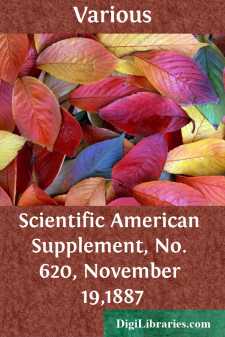Categories
- Antiques & Collectibles 13
- Architecture 36
- Art 48
- Bibles 22
- Biography & Autobiography 813
- Body, Mind & Spirit 142
- Business & Economics 28
- Children's Books 15
- Children's Fiction 12
- Computers 4
- Cooking 94
- Crafts & Hobbies 4
- Drama 346
- Education 46
- Family & Relationships 57
- Fiction 11828
- Games 19
- Gardening 17
- Health & Fitness 34
- History 1377
- House & Home 1
- Humor 147
- Juvenile Fiction 1873
- Juvenile Nonfiction 202
- Language Arts & Disciplines 88
- Law 16
- Literary Collections 686
- Literary Criticism 179
- Mathematics 13
- Medical 41
- Music 40
- Nature 179
- Non-Classifiable 1768
- Performing Arts 7
- Periodicals 1453
- Philosophy 64
- Photography 2
- Poetry 896
- Political Science 203
- Psychology 42
- Reference 154
- Religion 513
- Science 126
- Self-Help 84
- Social Science 81
- Sports & Recreation 34
- Study Aids 3
- Technology & Engineering 59
- Transportation 23
- Travel 463
- True Crime 29
Scientific American Supplement, No. 620, November 19,1887
by: Various
Categories:
Description:
Excerpt
BRISTOL CATHEDRAL.
BRISTOL CATHEDRAL.
An Augustinian monastery, founded by Robert Fitzhardinge in 1142, had its church, of Norman architecture, to which additions were made in the early English period. When Edmund Knowle was abbot, from 1306 to 1332, the Norman choir was replaced by that which now exists. His successor, Abbot Snow, built the chapels on the south side of the choir. Abbot Newland, between 1481 and 1515, enriched the transepts with a groined roof and with ornamental work of the decorated Gothic style, and erected the central tower. Abbot Elliott, who followed Newland, removed the Norman nave and aisles, intending to rebuild them; but this was prevented by his death in 1526 and by the dissolution of the monastery a few years afterward; he completed, however, the vaulting of the south transept. The church remained with a nave, and otherwise incomplete, until the modern restorations; after which, in 1877, it was reopened with a special service. Messrs. Pope & Bindon, of Bristol, were the architects employed. The exterior, of which we give an illustration, viewed from St. Augustine's Green, or Upper College Green, is not very imposing; from the Lower Green there is a good view of the central tower and the transept. The height of the tower is but 127 ft. It is of perpendicular Gothic architecture, but the piers supporting it are Norman. The interior presents many features of interest. The clustered triple shafts of the piers in the choir, with their capitals of graceful foliage, the lofty pointed arches between them, and the groined vaulting, have much beauty. The chancel is decorated with tracery of a peculiar pattern.
The Abbey of St. Augustine at Bristol was surrendered to King Henry VIII. in 1538, and became, in 1542, the cathedral of the new Episcopal see then created. The first Bishop of Bristol, Paul Bush, was deprived of his see by Queen Mary, being a married clergyman and refusing to part with his wife. Bishop Fletcher, in Queen Elizabeth's time, afterward Bishop of Worcester and of London, was twice married, at which this queen likewise expressed her displeasure. He was father of Fletcher, the dramatic poet; and he is said to have been one of the first English smokers of tobacco. Among noted Bishops of Bristol were Bishop Lake, afterward of Chichester, and Bishop Trelawny (Sir Jonathan Trelawny, Bart., of Cornwall), two of the "seven bishops"; imprisoned for disobeying an illegal order of James II. "And shall Trelawny die? Then twenty thousand Cornishmen will know the reason why." But the most eminent was Bishop Joseph Butler, the author of "The Analogy of Natural and Revealed Religion" and of the "Sermons on Human Nature." He was born at Wantage, in Berkshire, and was educated as a Nonconformist. He was Bishop of Bristol from 1738 to 1750, when he was translated to Durham. In 1836, the see of Bristol was joined with that of Gloucester; and the Right Rev. Drs. J.H. Monk, O. Baring, W. Thomson (now Archbishop of York), and C.J. Ellicott have been Bishops of Gloucester and Bristol.—Illustrated London News.
...











